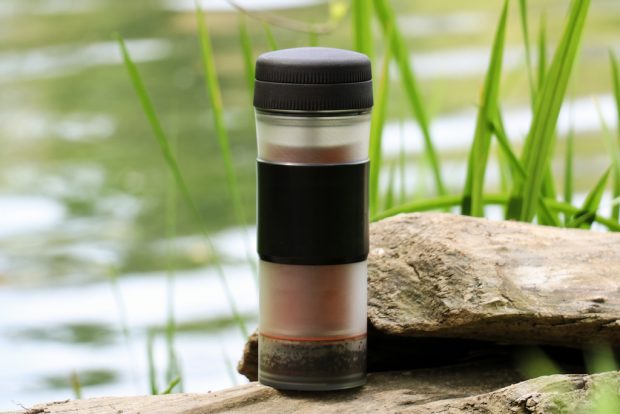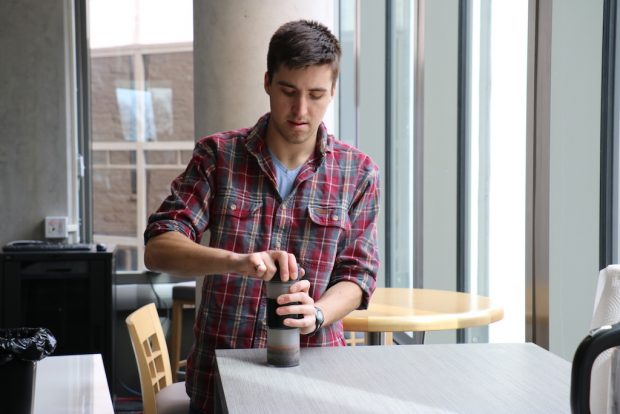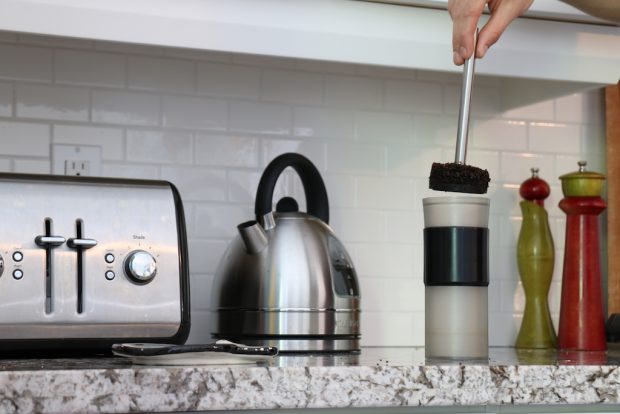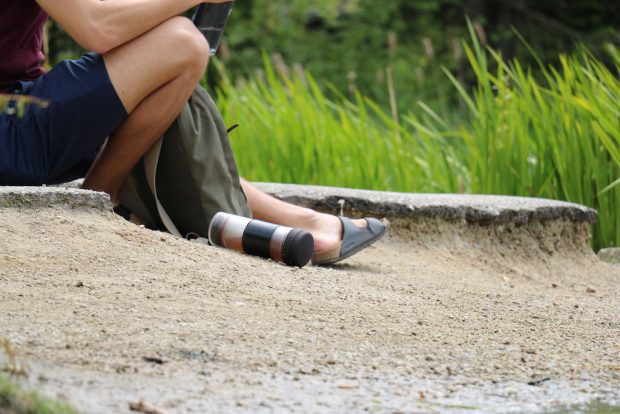As times goes by in the highly competitive field of portable manual coffee brewers, innovation becomes increasingly hard to come by, yet an upcoming product currently in pre-manufacturing development in Canada is poised to offer something new.
The Pascal Press, invented and developed by a mechanical engineer with a master’s in Thermofluids Engineering, combines elements of Aeropress, French Press and the moka pot into a single cupholder-friendly, leak-proof coffee making, carrying and drinking solution.
The Pascal Press consists of three essential cylinders. There’s the outer cup, into which the user inserts a stainless steel mesh filter of 200-micron fineness with a cylindrical rod in its center. This assembly resembles the filter system of a French press, but functions very differently. In the Pascal Press, the filter starts and remains at the bottom of the vessel, and the rod at its center is a hollow stainless steel tube. With this filter-rod assembly inserted, coffee is added on top of the filter, and then the water, for an Aeropress-style immersion brewing phase.
After however long the user wants — the company says an enjoyable cup can take less than a minute, depending on the grind — the third element comes into play, a stopper with a hole at its center that fits over the central tube that’s attached to the filter assembly. The user presses down on the stopper, using the seal formed between the stopper’s gaskets and the vessel’s inner wall to direct pressure on the brew, which is another similarity to the Aeropress, forcing the brew down through the filter and, in moka pot-like fashion, up through the center tube and out into the device’s central containment area.
Unlike the Aeropress, though, there’s no additional filter required, paper or otherwise, nor does its use depend on having any other cup, stand or receptacle. And unlike the French press, the base of the stopper constitutes an actual solid barrier between the spent grinds and the finished brew, thoroughly preventing any continued interaction between the two.
A layer of warm air is captured between the stopper-container and the outer vessel, creating a sort of double-wall insulation that the company claims will maintain the coffee’s temperature for up to two hours. A leak-proof cap screws onto the top, and off the user goes. To clean, the user pulls the filter out by its rod, taps off the grinds and gives it all a quick rinse.
“I find the short wet time and high pressure brew makes an amazingly smooth yet strong cup of coffee,” Pascal Press founder and inventor Alan Kalbfleisch told Daily Coffee News. Kalbfleisch is the sole full-time member of the Pascal Press team for now. “I used to brew with a French Press and could never get it right. It would always come out too bitter and I would have to add milk to it in order to drink it.”
To develop the press, Kalbfleisch was able to take advantage of resources such as business consultation as well as funding for patents and prototypes provided by the Propel Entrepreneurship Center at Western University, from which he recently graduated. He also depended on the support of friends in such fields as web design, photography, finance, marketing and venture capitalism to bring the project from thought to reality, while a home coffee-roasting enthusiast that works at the university’s engineering department machine shop was helpful not only in facilitating fast, high-quality prototypes but in considering the coffee parameters at play.
“For me, Pascal Press began as an engineering challenge,” said Kalbfleisch, who has no professional coffee background. “It started as a passion project bringing my love of coffee together with my experience as a Thermofluids Engineer. Some members of my ‘team’ are self-proclaimed coffee snobs that were more than happy to test my prototypes.”
Kalbfleisch has also brought Pascal Press prototypes to area cafes and roasteries for consultation with local pros, including David Cook, owner of Fire Roasted Coffee Company based in London, Ontario. “Dave’s staff, which included his head roaster, agreed that Pascal Press was great at bringing out the intended flavors of a roast in a clean and smooth coffee with no bitterness” said Kalbfleisch. “For a medium roast, the brewed coffee kept the flowery aroma and acidity. For a darker roast, the strong flavors were in the coffee with no over powering bitterness.”
The Pascal Press inventor has not yet measured exactly how many Pascals of pressure are recommended for optimal use, though he admitted he should probably find out. A Pascal (Pa), named after the French polymath Blaise Pascal, is a unit pressure defined as one newton per square meter. For reference, 6,900Pa equals roughly 1 psi.
Newtons notwithstanding, Kalbfleisch’s current preferred recipe is a dose of roughly 25 grams of coffee ground medium-fine, mixed with 14 ounces of water at 200F for a steep time of between 30-60 seconds followed by a 15-second press. The inventor hopes other users discover whatever recipes work for them as they please, for each coffee they try.
While there may eventually come Pascal Presses with different color silicon bands and lids and additional filters of varying fineness, there are no immediate plans to offer a multi-cup version or any other products or accessories. “As the area of the plunger face increases, the pressure generated by an equal force will decrease (see Pascal’s Law),” said Kalbfleisch of the multi-serving idea. “I will most likely be sticking with the single-serve unit for the time being.”
Kalbfleisch will launch a Kickstarter campaign towards the end of June to fund manufacturing of the Pascal Press, after which he intends to give it a confident, unhurried six months to reach backers and then the wider public. “I would love to see the Pascal Press sold in local coffee shops and outdoor gear stores like REI or MEC,” said Kalbfleisch. “I will most likely have online sales as well.”
Howard Bryman
Howard Bryman is the associate editor of Daily Coffee News by Roast Magazine. He is based in Portland, Oregon.
Comment
1 Comment
Comments are closed.










Interesting. But what do I do with the lid when I want a sip? Someone needs to invent a leak proof “sippy cup” lid. Perhaps this lid could be screwed onto the bottom when drinking. Maybe a slip in drinking lid like the Nalgene bottles. Anyone who has ever tried hiking/walking with an open coffee cup knows it will spill eventually. But then I like to sit down and relax when having my coffee. Otherwise, it’s a great idea. I’m waiting for the kickstarter.